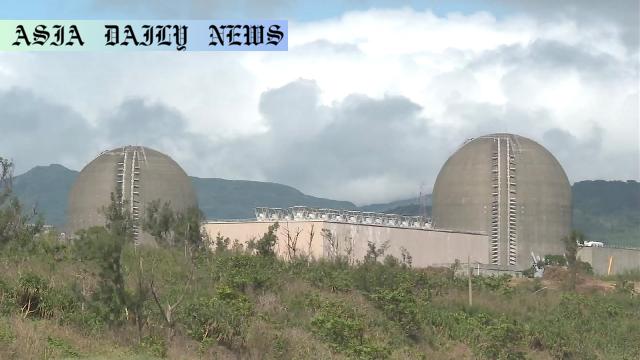Nuclear Power: Taiwan’s ruling party moves to halt its only nuclear plant amid concerns while aiming for 20% renewable energy next year.
- Taiwan will shut down its only operational nuclear plant on Saturday.
- Ruling party transitions away from nuclear energy amid safety concerns.
- Energy focus shifts to renewables and thermoelectricity by 2024.
- Critics warn of unstable energy supply, increasing costs in Taiwan.

Introduction: Taiwan’s Historic Energy Shift
In a significant step towards reshaping its energy landscape, Taiwan is set to shut down its only operational nuclear power plant on Saturday. This pivotal transition stems from a broader commitment by the ruling Democratic Progressive Party (DPP) to move away from nuclear energy and capitalize on alternatives such as liquefied natural gas and renewable energy sources. This decision aligns with years of public apprehension regarding nuclear safety, exacerbated by the Fukushima nuclear disaster in 2011. However, it raises essential questions about the stability of Taiwan’s energy supply and future economic impact.
Public Concerns Following Fukushima
The Fukushima disaster in Japan acted as a stark reminder of the inherent risks that accompany nuclear power. In Taiwan, this event amplified existing worries and nurtured a strong anti-nuclear sentiment among its populace. Many citizens and environmentalists have cited potential seismic vulnerabilities as a strong argument for transitioning away from nuclear energy. Despite nuclear power’s efficiency in energy generation and reduction of carbon emissions, its perceived risks have made it a contentious issue among the public and political parties alike.
Renewables and Natural Gas as Future Pillars
The government of Taiwan envisions a near future where renewable energy sources fulfill a significant portion of the nation’s electricity demands. By 2024, authorities aim to generate 20 percent of Taiwan’s electricity through wind, solar power, and other renewable options. Simultaneously, thermoelectricity fueled by liquefied natural gas (LNG) will supplement the transition. However, these measures come with their challenges, including high costs for LNG and the significant investment required to develop renewable infrastructure on a large scale.
Criticism and Counterarguments
Not everyone supports the decision to move away from nuclear energy. Opposition parties and industry experts have raised alarms about potential power shortages and soaring electricity bills. Nuclear energy offers a relatively affordable and consistent power supply, characteristics not easily replicated by renewable sources or LNG. Critics argue that an over-reliance on LNG could build additional dependencies on imports, which exposes Taiwan to geopolitical vulnerabilities and fluctuating global market prices.
Taiwan’s Energy Landscape in the Global Context
Taiwan’s decision mirrors a global trend seen in several nations opting to diversify their energy sources. However, the success of this transition depends substantially on strong government policies, public cooperation, and technological advancements. While renewable energy holds immense promise, developing sufficient infrastructure and addressing intermittency challenges remain significant barriers. Taiwan must learn from countries that have faced similar challenges and seek innovative solutions to secure a sustainable energy future.
Long-Term Impacts and Sustainability Goals
While the immediate focus lies in ensuring stable energy supplies, shutting down the last nuclear plant also represents Taiwan’s long-term commitment to global sustainability goals. Reducing dependence on non-renewable energy aligns with international efforts to combat climate change. However, fulfilling electricity demand sustainably without inflating costs will require astute planning, collaboration, and investment into research and development. Taiwan’s energy transition could further establish the country as a leader in forward-thinking energy solutions in Asia.
In conclusion, Taiwan’s decision to close its last nuclear power plant underscores its commitment to renewable energy and public safety. However, the transition must balance the complex dynamics of energy security, affordability, and environmental sustainability to ensure long-term success.



Commentary
Balancing Risks and Opportunities
As Taiwan embarks on this transformative journey to retire its last operational nuclear power plant, there exists a delicate balance between addressing public safety concerns and ensuring a steady power supply. The shadow of Fukushima continues to loom over nuclear discussions globally, providing a valid rationale for many nations, including Taiwan, to diversify their energy portfolios. The transition, however, is neither simple nor free from its own set of drawbacks. Energy security and affordability are pressing matters that directly impact industries, households, and the nation’s competitiveness as a whole.
The Promise of Renewable Energy
The emphasis on renewable energy sources like wind and solar power is undeniably a progressive step forward. These technologies not only offer cleaner energy but also have the potential to minimize long-term costs once initial barriers of scale and infrastructure are overcome. Furthermore, Taiwan’s goal of sourcing 20 percent of its electricity from renewables by next year reflects a strong commitment to reducing carbon emissions and tackling climate change. However, renewables, often hampered by intermittency, require complementary solutions to ensure year-round reliability. Energy storage systems, smart grids, and diversified sources are key to overcoming these challenges.
The Role of Community and Policy
Meaningful engagement with various stakeholders will play a crucial role in the success of this transition. The government must transparently communicate the long-term benefits of renewable energy to gain public trust, especially in light of the short-term challenges posed by rising electricity prices or potential energy shortages. Proactive policies aimed at incentivizing private investments in renewables and promoting energy efficiency can further accelerate this journey.
Taiwan stands at a crossroads that symbolizes the broader global pursuit of energy sustainability. By aligning economic strategies with environmental commitments, the nation has an opportunity to set itself as a leader in clean energy innovation. However, as with any ambitious project, success will depend on determined efforts, adaptive strategies, and unwavering focus on the collective good.